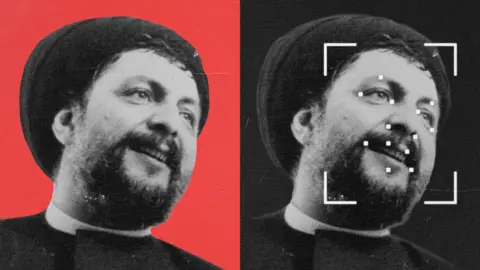Body seen in secret Libyan mortuary could help solve 1978 disappearance of Musa al-Sadr
BBC Eye investigation digitised a decomposed corpse photo; a UK computer scientist will run an algorithm as families and supporters seek answers nearly 50 years on
A photograph of a decomposed corpse found in a secret mortuary in Tripoli could provide new evidence in the long-unsolved disappearance of Lebanese Shia cleric Musa al-Sadr, the BBC’s Eye Investigations team reports.
The image, taken by a journalist who was shown the body in 2011, has been digitised and is being examined by Professor Hassan Ugail of Bradford University. "This is what he looks like now?" Prof Ugail asked as he viewed the degraded facial image, which the BBC said is to be analysed using a special algorithm as part of the ongoing investigation.

Musa al-Sadr vanished in Libya in 1978 during a visit that has long been shrouded in mystery and competing narratives. His disappearance has spawned conspiracy theories and enduring calls for accountability. Some supporters and observers say he was killed; others have alleged he remained alive and detained in Libya for years. For many of his followers in Lebanon and beyond, the question of what happened to him has a level of emotional and political resonance comparable to other famously contested political disappearances.
The BBC team said the 2011 photograph was taken inside a mortuary that the journalist was told was secret. The digitised image shows a decomposed face; investigators plan to run facial-matching and enhancement techniques to compare the corpse to known photographs of Sadr and to estimate age and identifying features. Prof Ugail, a computer scientist at the university in northern England, has applied forensic imaging and algorithmic analysis in other identification efforts.
The investigation’s reporting team faced dangers while pursuing leads in Libya. The BBC said members of the World Service team were detained in the country for several days during the course of their reporting. The detention underlined the sensitivities surrounding Sadr’s disappearance and the fraught political context in Libya since the end of Muammar Gaddafi’s rule.
Musa al-Sadr, a charismatic cleric and political organiser, rose to prominence in Lebanon in the 1960s and 1970s and helped mobilise parts of the Shia community. He travelled to Libya in 1978 at the invitation of Libyan leader Muammar Gaddafi, and was never seen publicly afterwards. His disappearance has prompted repeated demands for information from family members, political leaders and rights groups in Lebanon, and has been the subject of international scrutiny and longstanding public debate.
Previous inquiries and efforts to establish the facts have produced partial leads but not a definitive, universally accepted account of Sadr’s fate. Libyan authorities under Gaddafi maintained different versions over the years; after the 2011 uprising and Gaddafi’s fall, a number of documents and testimonies emerged that renewed scrutiny of what occurred in 1978 and in the decades that followed.
The BBC said its investigation aims to corroborate physical evidence with archival material and testimony. Any forensic match would not by itself resolve all legal or political questions but could supply important new evidence for families and authorities seeking closure. Those closely connected to Sadr’s legacy — both his followers and political interlocutors in Lebanon — have repeatedly called for transparency and fuller disclosure from Libyan and other relevant authorities.
The investigation is ongoing. Analysts and family representatives said they will await the outcome of the image analysis and any corroborating documentary or testimonial evidence before drawing conclusions. The BBC report cautioned that the image and the mortuary claim are sensitive and that the work involves both technical challenges and political complexities that may affect what can be established and when.